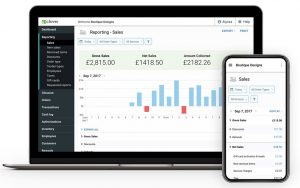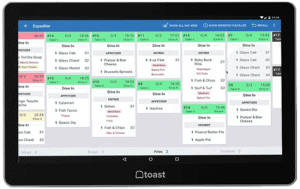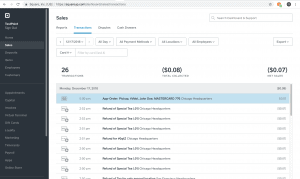
To underline the importance of having a suitable point-of-sale system for your delivery business and to explain why choosing nothing but the best is crucial for scaling and growing it, we’ll dive into the details related to POS for delivery.
Contents
What Is a POS System?
We understand that some business owners have never thought that having a point-of-sale system would be a great addition to their operations. If you are part of that group, then you would like to learn more about what a POS system is and how it works.
In short, a POS system is a combination of software and hardware you use as a checkout point and a way to control and manage multiple aspects of your business. It could be a working solution for both online and offline businesses.
POS systems are very different and the right one for your business depends on its niche, structure, scale, and several other aspects. Today, small and medium-sized business owners prefer modern point-of-sale solutions thanks to their mobility, flexibility, and advanced options that help you manage a plethora of management aspects with ease.
Having a state-of-the-art point-of-sale system will allow you to accept and process payments and keep track of several metrics at the same time. There was a time when POS systems were only associated with cash terminals, but technology in this sector has come a long way since then.
How Does a POS System Work?
POS systems can be very different, but there are things in common between all of them:
- Making a sale: When your client buys your services or goods, the payment must be processed. This may involve scanning barcodes or QR codes or virtual checkouts (when you make a sale online).
- Price calculation: With both physical and virtual shopping carts, the right POS system for your business will handle all aspects of accepting the payment and proceeding with the transaction, starting with an accurate price calculation.
- Payment: Once the two initial steps are completed, the payment needs to be made via any possible means chosen by the client and/or supported by the POS system, including cards (debit, credit, gift cards), cash, mobile wallets, apps, and more. A transaction authorization will follow.
- Finalizing the transaction: Once the transaction is completed, the sale is over. This usually happens not too long after the time of the checkout.
Common POS Software Features
Needless to say, the biggest difference between the types of POS you can find today comes down to the number of features. Even the basic systems you can choose will help you manage your business with better efficiency and accuracy and with less effort.
The features that are typical for most point-of-sale systems include:
- Payment processing: This, of course, is the basic functionality of a POS system. It’s a must-have for every type of operation imaginable.
- Multiple payment types support: The best POS for delivery (and for any other business) would be able to support a large variety of payment means (we already listed some of the most popular ones above).
- Reporting tools: Your POS system needs to have several reporting tools that will keep you informed about sales and profit. Analyzing these reports will help you scale your operation and manage it in the best possible way.
- Staff management: Many modern point-of-sale solutions can monitor your employees’ performance and help you create their schedules.
- Inventory management: Keeping an eye on your stock quantities will be easier with a proper POS system that can help you update your inventory after each sale.
- CRM: Being able to track your clients’ behavior and analyze details about their purchase history will let you create a better relationship with them and a clear understanding of their needs.
- Tipping: Delivery and hospitality businesses need a proper tool to allow for tipping, as it’s an important part of the employees’ payment.
Specific POS for Delivery Businesses: The Booming Delivery Service Industry Requires It
As a delivery business owner, you surely know most of the trends in this niche and you can confirm that the industry has been growing at a fast pace. While the global pandemic limited the growth of some industries, it caused others to flourish. This is the case with delivery companies worldwide.
Today, delivery operations such as food companies and couriers have more clients than ever before. Plus, they have all the means to reach them and present them with the best client experience possible. This means that having the best POS for delivery is a must.
Online food and groceries delivery, for example, has become a multi-billion-dollar niche that already passed the $200 billion mark. There are no signs of stopping this trend, too: the numbers quoted are about to surge in the next years, according to several studies and financial institutions that constantly monitor the market.

Having a modern POS for delivery will help you keep up with the biggest trends in the delivery industry, including hiring third-party delivery partners, subscriptions, online grocery purchasing, and more. Considering the rising competition and the importance of being able to track all kinds of data in order to be one step ahead of the rest, there is no doubt that having a proper POS for delivery solution is key for your operation’s growth.
Having a fleet of couriers or food delivery drivers requires a state-of-the-art POS for delivery system that will handle all processes related to this kind of business. What’s even more important is the system’s ability to create a seamless experience for the client and gather as much information for the sale and the delivery as it could. The reporting tools of a POS for delivery setup are key for every company in the business.
If you are running a DaaS (delivery as a service) operation, then you probably run an online ordering portal, meaning that your POS system will have to be capable of accepting online sales preceding the delivery. In some cases, payments are processed at the moment of delivery instead of being an online transaction. Having a point-of-sale solution that covers both will help you never miss making a sale.
There is no doubt that having your own delivery fleet is probably the scenario with the least hustle and bustle. For the last five years, this type of delivery business has picked up speed. Many restaurant chains switched to having their own delivery fleets. To manage them, they all need a proper POS for delivery that would not only process payments but also help them monitor the staff members’ performance and manage inventory and schedules. Being able to manage both sales and delivery in-house gives you control and makes for smoother coordination between different departments.
Still, the larger the scale of your business, the more difficult it would be to run it, which is why some business owners prefer to have a third-party delivery fleet. Regardless if you have your own delivery team or you prefer working with partners to cover that part of the business, you still need a proper tracking toolset. The right POS for delivery you choose would surely have several functionalities that will help you gather valuable data. The system should be able to store and process it, creating a reporting sequence that will help you reduce your error rate and perfect your clients’ experience thanks to extensive analysis. It is the easiest way for you to introduce changes to the operations you run and to up their overall performance.
When it comes to online grocery sales and delivery, having a POS system that can combine both online and offline functionalities is a must. But that’s not the only important feature of such a system. What you need is a POS for delivery setup that has extensive customer loyalty and behavior management toolset. It will allow you to recognize your clients’ habits and preferences.
Types of POS for Delivery
Of all the types of point-of-sale systems available today, only a couple would be a fitting solution for delivery businesses. Traditional checkout systems featuring a cash drawer and a locally installed server are obviously not the ones that would be suitable POS for delivery that couriers and food delivery companies would choose. If you’re running a delivery business, then you’ll need to choose one of the types of POS systems we’ll take a closer look at below.
POS Apps
One of the latest additions to the world of POS systems is the variety of point-of-sale applications that are compatible with several operating systems, including Android and iOS. Some of these apps are free and usually require a simple setup to be up and running in no time.
POS apps are cloud-based, meaning that all you would need to use them is an internet connection and a compatible mobile device. Once you set up the app, you can access it from wherever you are. This combination of flexibility and mobility turns these apps into a perfect POS for delivery.
While some POS apps can be installed on multiple platforms and devices, others are specifically designed for a certain type of device or an operating system.
Most POS apps do not have the full set of features and tools typical of traditional POS setups, but they do have the important ones. There are also different processing fees to consider, but the much lower initial investment is an advantage you can never neglect – some POS apps are completely free to set up.
POS apps are an ideal solution if you need a reliable point-of-sale system on the go. If your employees need to be at multiple locations daily (typical for any delivery operation), then it’s the type of POS for delivery to choose. Considering the low initial investment and the easy (and mostly free) updates, this solution is an opportunity for small delivery companies or startups to have a competitive advantage and grow. Possible additional features such as appointment planning tools are of great assistance to delivery businesses.
Mobile POS Systems
Mobile POS systems are gaining momentum, as business owners everywhere continue to recognize their multiple advantages. Also known as mPOS, mobile point-of-sale solutions are the best choice for retail and hospitality operations, but they are also an ideal solution for mobile merchants, kiosks, and delivery companies. As a POS for delivery solution, these systems can serve all purposes imaginable. They also support both online and offline payment processing, allowing for flexible sales and delivery processes.
In most cases, mPOS systems for delivery businesses use a smartphone or a tablet as the only piece of hardware needed to input orders and carry out transactions. If you’re in search of the best POS for delivery option, then you’ll need to study all the expenses related to implementing such a solution and compare them to your budget.
- Hardware costs: If you’re lucky, the mobile POS for delivery you would find to be a good fit for your business would be free and compatible with your existing hardware. Some POS vendors, however, sell their own mobile devices that are the only ones compatible with their software.
- Software costs: Even when the POS software you choose is free to install, there might be steep monthly subscription payments or other fees. Additional software extensions or integrations may also be pricey.
- Payment costs: Payment processing is usually done by either the POS supplier or a third-party processor. Either way, you need to know in advance all the transaction fees you would owe.
The best thing about mobile POS for delivery is its cloud-based structure and accessibility. You can run the point-of-sale software from anywhere you like or need. In general, mobile point-of-sale systems for delivery companies are easy to integrate with other software and hardware.
Another obvious advantage is the availability of payment processing on the go, but that can be combined with other checkouts your business might need, such as offline or e-Commerce ones. In short, your operation may involve all kinds of checkout solutions that you can manage from any desired location.
Having a mobile POS for delivery will help you run your operation faster and more efficiently, not to mention the higher client satisfaction level you will achieve. On the downside, mobile POS systems for delivery businesses may cost you more initially. Some of these systems are also not compatible with other operating systems apart from iOS. As mentioned above, some POS for delivery solutions may require you to purchase the POS vendor’s proprietary hardware units.
POS for Delivery: The Vendors You Should Check Out First
There are only a couple of types of POS for delivery setups to choose from, but there are also several different vendors who offer point-of-sale solutions that might be a good fit for your business. Since you are likely to find more than one POS system that’s suitable for your business, you need to compare the options down to the last detail. The best one would represent a winning combination of reasonable initial investment, an extended toolset, and the flexibility your delivery business needs.
Let’s take a look at a few of the most popular POS for delivery choices available today.
Clover

Except for the astounding Clover Flex all-in-one piece of hardware that will cost you $499, you can also choose the Clover Go card reader (priced at $99) that you can attach to a mobile device such as a smartphone or a tablet. You can get the Clover POS software for a monthly subscription fee of $9.95 or higher. When it comes to payment processing, the fees depend on the monthly plan you chose. If you stick to the basic one, you will own 2.6% plus $0.10 per transaction. For online transactions, the fee is higher: 3.5% plus $0.10 per transaction.
If you decide to go for Clover’s POS system, you should know that there is no free plan available. The good news is that Clover Go is compatible with many mobile devices, meaning that you will not be forced to buy proprietary equipment supplied by the vendor.
Toast

The software provided by Toast is free to use in its basic plan. The payment processing fees you would pay are always individual. Every client receives a custom quote. It all comes down to your specific niche and your business model and scale.
If you want to take advantage of the POS for delivery and restaurants supplied by Toast, you must be prepared to sign a two-year contract. The hardest thing to decide whether to go with it or not is the fact you won’t be able to compare monthly rates and transaction fees to the ones offered by the competition.
Square

Similar to Clover Flex and Toast Go 2, Square Terminal is a combined device featuring a built-in printer. The difference is that the latter is cheaper. Square Terminal’s retail price is $299. You can opt for a reader for card magnetic stripes instead, which is free. It would likely work with the smartphone or tablet you already have.
Square’s contactless card reader is also compatible with most mobile devices and could be yours for $49. The device can read NFC chips and even accepts mobile wallets such as Google Pay and Apple Pay. The downside is that you need to have both devices if you want to be sure you could accept all types of card payments possible. Generally speaking, Square’s POS hardware is best paired with iOS-powered devices. If you plan on combining it with Android devices, you need to be certain of the compatibility between the two.
As for payment processing, you will pay 2.6% plus $0.10 per transaction if you stick with the basic free plan of Square’s POS for delivery system. Online transactions will cost you 2.9% plus $0.10. You won’t have to sign a contract, too. Square allows you to use its POS system month-to-month.
The Conclusion
The delivery industry across the world is now at its highest point ever. This is the aftermath of several factors, but it’s mainly due to changes in the way people shop and interact with retail and hospitality businesses. With that said, there is no wonder that delivery businesses had to adapt to the higher demand for their services and the rising competition. If you are one of them. You know that where an opportunity lies, there are also obstacles to overcome.
To make sure you have what it takes to stay afloat and provide your clients with the best experience possible, you need the right POS for delivery that fits perfectly to your operation. You can choose from mPOS systems and POS apps. The good news is that there are enough trusted point-of-sale vendors to compare. Once you are certain your requirements are met, then you can go for the POS system that got your attention.
Author: Written by Martin Nikolaev. Martin has 5+ years of experience in reviewing various tech gadgets, FinTech solutions, crypto markets and products, and all IoT-related products. This article was published on Friday, 10 June 2022.
FAQ
Which are the most suitable types of POS for delivery?
Of all the different types of point-of-sale solutions, POS apps and mobile POS systems are the most suitable and feature-rich systems you can pick.
What should you consider before opting for a particular mobile POS for your delivery business?
The most important things to consider before investing in a mobile POS system are the costs of the software, hardware, and payment processing.
What are the most important features of a proper POS system?
The most suitable POS system should feature functionalities such as inventory management, tipping support, employee monitoring, reporting tools, and more.
Are POS apps compatible with all types of devices?
There are POS apps that are compatible with most operating systems. However, certain cloud-based point-of-sale systems require specific hardware.

